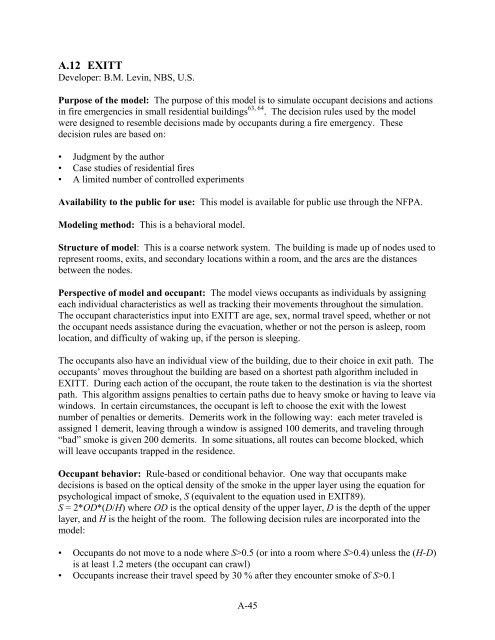A Review of Building Evacuation Models - NIST Virtual Library
A Review of Building Evacuation Models - NIST Virtual Library
A Review of Building Evacuation Models - NIST Virtual Library
Create successful ePaper yourself
Turn your PDF publications into a flip-book with our unique Google optimized e-Paper software.
A.12 EXITT<br />
Developer: B.M. Levin, NBS, U.S.<br />
Purpose <strong>of</strong> the model: The purpose <strong>of</strong> this model is to simulate occupant decisions and actions<br />
in fire emergencies in small residential buildings 63, 64 . The decision rules used by the model<br />
were designed to resemble decisions made by occupants during a fire emergency. These<br />
decision rules are based on:<br />
• Judgment by the author<br />
• Case studies <strong>of</strong> residential fires<br />
• A limited number <strong>of</strong> controlled experiments<br />
Availability to the public for use: This model is available for public use through the NFPA.<br />
Modeling method: This is a behavioral model.<br />
Structure <strong>of</strong> model: This is a coarse network system. The building is made up <strong>of</strong> nodes used to<br />
represent rooms, exits, and secondary locations within a room, and the arcs are the distances<br />
between the nodes.<br />
Perspective <strong>of</strong> model and occupant: The model views occupants as individuals by assigning<br />
each individual characteristics as well as tracking their movements throughout the simulation.<br />
The occupant characteristics input into EXITT are age, sex, normal travel speed, whether or not<br />
the occupant needs assistance during the evacuation, whether or not the person is asleep, room<br />
location, and difficulty <strong>of</strong> waking up, if the person is sleeping.<br />
The occupants also have an individual view <strong>of</strong> the building, due to their choice in exit path. The<br />
occupants’ moves throughout the building are based on a shortest path algorithm included in<br />
EXITT. During each action <strong>of</strong> the occupant, the route taken to the destination is via the shortest<br />
path. This algorithm assigns penalties to certain paths due to heavy smoke or having to leave via<br />
windows. In certain circumstances, the occupant is left to choose the exit with the lowest<br />
number <strong>of</strong> penalties or demerits. Demerits work in the following way: each meter traveled is<br />
assigned 1 demerit, leaving through a window is assigned 100 demerits, and traveling through<br />
“bad” smoke is given 200 demerits. In some situations, all routes can become blocked, which<br />
will leave occupants trapped in the residence.<br />
Occupant behavior: Rule-based or conditional behavior. One way that occupants make<br />
decisions is based on the optical density <strong>of</strong> the smoke in the upper layer using the equation for<br />
psychological impact <strong>of</strong> smoke, S (equivalent to the equation used in EXIT89).<br />
S = 2*OD*(D/H) where OD is the optical density <strong>of</strong> the upper layer, D is the depth <strong>of</strong> the upper<br />
layer, and H is the height <strong>of</strong> the room. The following decision rules are incorporated into the<br />
model:<br />
• Occupants do not move to a node where S>0.5 (or into a room where S>0.4) unless the (H-D)<br />
is at least 1.2 meters (the occupant can crawl)<br />
• Occupants increase their travel speed by 30 % after they encounter smoke <strong>of</strong> S>0.1<br />
A-45
















